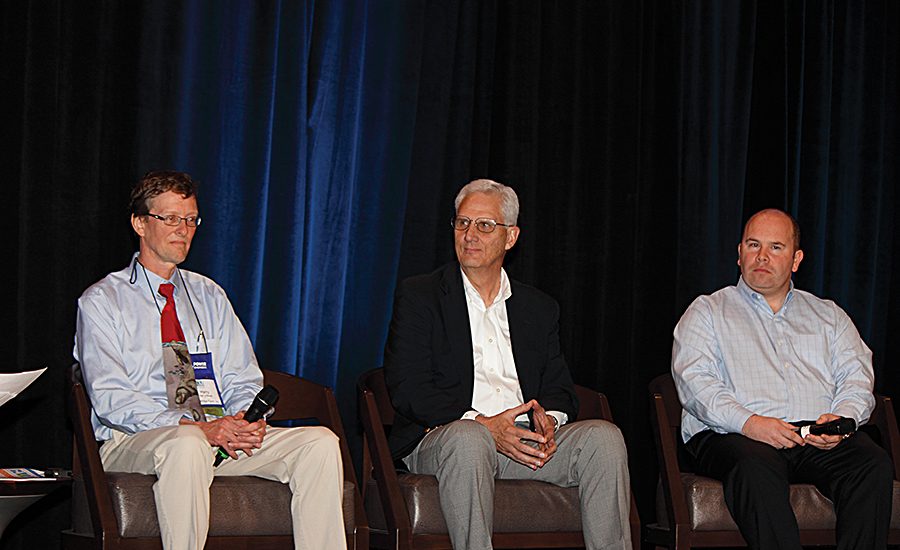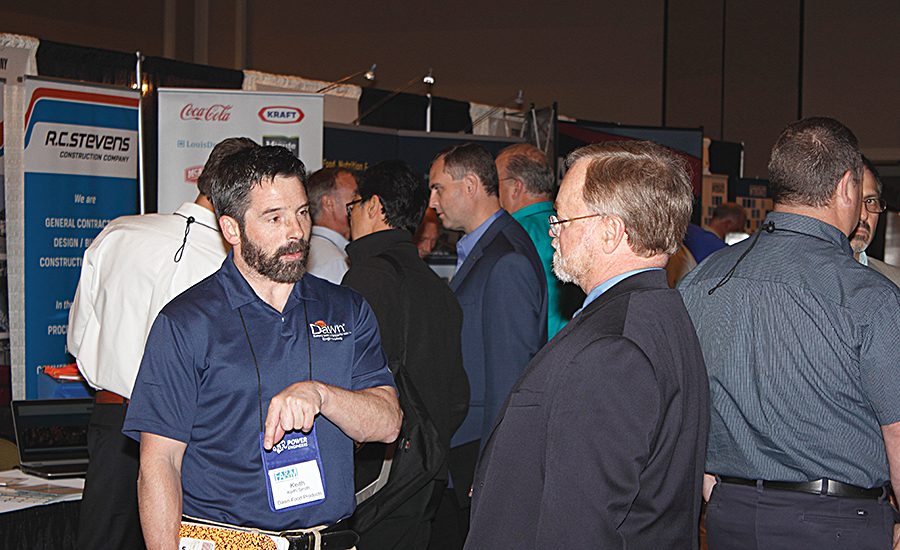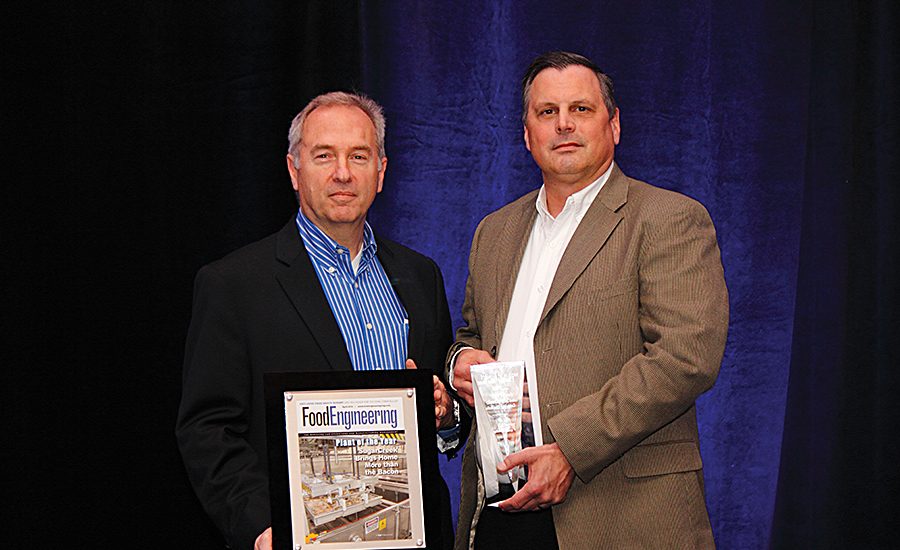At first, it might seem odd that many of the presentations during this year’s Food Automation & Manufacturing Conference focused on people. However, people are at the center of many of the challenges food and beverage companies currently face. FA&M sessions also covered topics such as the increasingly technological environments of modern processing plants and how companies can produce better-quality products.
The people business
Gregg Stedronsky, vice president of engineering, global safety and environment and manufacturing excellence for General Mills, delivered the engineering keynote address, “Harness the power of automation and information to achieve manufacturing excellence,” which explored how the application of increasingly available technology affects employees.
A 150-year-old company, General Mills is no stranger to change. As Stedronsky said, “We’ve evolved before, and we’re evolving again.” This time, the company is responding to more consolidation in the industry and shifting consumer values. “We’re all going through a lot of change,” he said, with challenges such as getting more from the asset base and meeting new consumer demands for “real foods.”
Stedronsky recalled when he was first put in charge of the engineering department at General Mills. He evaluated some of the other companies in the landscape and asked himself a series of questions, such as why some were doing better than others, why some were able to produce cheaper foods and why some were more reliable. He determined that, for a food processor, nothing is more important than safety and being dedicated to taking care of people. He explained this is what it means to establish a culture of caring, which includes, but is not limited to, engaging employees and having faith in them.
In 1996, General Mills started to employ automation as a solution, embracing technology and automating units. The lesson learned, Stedronsky said, was management had to simplify the processes in the plant because “simplicity is caring.” Meanwhile, the company continued to increase efficiency, reduce variation and invest in information by collecting more data.
Through the years, General Mills’ automation space has grown, with manufacturing execution systems (MES) connecting processes. This connection has helped manage the proliferation of SKUs, which have grown from 10,000 in 2004 to approximately 35,000 today. According to Stedronsky, automation has led General Mills to where it is now and is delivering returns in terms of producing more throughput, greater reliability and better safety rates.
The key to creating a culture of caring and excellence, Stedronsky said, is for great leaders to focus on safety by upholding the established standards, having a vision that guides investment and embracing manufacturing as a people business.
The session entitled, “Workforce engagement in maintenance and automation operations” delivered by former Unilever Maintenance Manager Marques Young, echoed these thoughts. According to Young, there is possibly no better reminder that food manufacturing is a people business than when it is time to recruit. He added the staffing problems facing the industry are monumental, including the issue of baby boomers retiring and taking much of the institutional knowledge with them at the same time manufacturing is experiencing an economic expansion.
Part of the solution to filling these jobs must come from recruiting 18- to 24-year-olds, said Young. The challenge facing the industry is how to make these technical jobs, which are rarely viewed as “sexy,” more attractive to the Millennial Generation. Young recommended creating a talent pipeline by developing relationships with local schools and creating ways to engage students to make the jobs more enticing.
Safer foods and the food safety culture
Typically, food companies with a culture of caring consistently deliver safe products that meet consumers’ needs. Providing best practices on promoting food safety, two speakers from Abbott Nutrition gave the presentation, “Attaining top levels of quality and sanitary design.”
Wendy Fox, manager of microbiological services for Abbott, discussed having an environmental monitoring plan to prevent and/or control microbial contamination. An environmental monitoring plan helps map out where organisms are and identify how they enter a facility. Fox stated that by dividing a plant into zones, the required amount of microbial testing can be determined based on the activities in them, i.e., the lowest amount in locker rooms and offices and the highest amount in areas where product is handled without another kill step.
Peter Hahn, technical consultant for Abbott, discussed the benefits of clean-in-place sanitation. Because CIP combines the physical and chemical cleaning of equipment, the process can reduce cleaning time and optimize water, chemical and energy usage. It also minimizes cross-contamination and helps control allergens in a plant.
Don Monday, architectural engineering manager for Nestlé USA and Canada, delivered a presentation entitled, “Implementing sanitary plant design,” which focused on building environments that facilitate both people and product safety. He explained this safety is achieved through designs that have cleanable detailing and appropriate zoning and plans for the flow of raw and packaging materials, finished goods, wastes and people to control potential contamination from microorganisms, allergens and other hazards.
Monday added sanitary buildings are important to ensure the production of safe, quality foods and keep people safe and healthy. Well-designed buildings can also contribute to energy savings and preserving the image of a brand. Some design best practices include having self-draining ledges, avoiding exterior ledges that birds can nest on, rounding off corners, eliminating hollow bodies and limiting openings to the exterior of the building.
Chasing perfection through automation
This year’s FA&M Conference also emphasized preparing processors for the future of manufacturing. Delivering the automation keynote address were two people from Sierra Nevada Brewing: Brewmaster Scott Jennings and Technical Brewing Specialist Kirk Smith. The two focused on the 36-year development of Sierra Nevada, one of the original craft breweries.
Founder Ken Grossman started the company in Chico, CA in 1976, with what Jennings called the singular goal to produce the highest-quality beer by “chasing perfection.” Because the brewery was housed in a small warehouse with few employees, the initial quality judgments were based on human observations. However, as the brewery grew and, in 2013, constructed an additional location in Mills River, NC, more automation was employed to help further the company’s continued improvement.
Smith said a Brewmaxx process control system is being used to troubleshoot inefficiencies in the North Carolina plant. For instance, when a flow problem was identified in the data that showed the beer mash was becoming stuck, the system determined poor malt quality with a higher amount of dust and smaller particles was preventing the water’s passage. Smith added the system made this analysis possible and continues to help the facility improve its sustainability efforts, such as reducing the amount of water used in production.
“We’ve integrated a number of systems into an overall plant concept,” said Jennings. “We’re a growing company in a growing segment of our industry, most of which is populated by small operations that don’t have a lot of automation. But these tools have enabled us to maintain and improve the quality and sustainability of our product.”
Ed Rodden, chief information officer for SugarCreek, expanded on the concept of information improving manufacturing operations in his presentation, “Understanding and utilizing the Internet of Things.” In the presentation, he explained the “Internet of Things” is about the expansion of connecting disparate data sets to produce meaningful insights to help manufacturers anticipate needs, reduce expenses and attain higher levels of service.
Plant of the Year winners, now and then
Each year, the highlight of the FA&M Conference is the Plant of the Year Award ceremony. This year, SugarCreek was honored for its facility in Cambridge City, IN. The largest independent bacon processor in the US, SugarCreek operates as a co-packer and co-developer. Its plant was recognized for its forward-thinking food processing technologies, which includes a 10-tank sous vide system capable of cooking 90,000 pounds of meat, as well as infrared baking equipment.
The building site has a separate wastewater treatment facility, where water can be recycled via dissolved air flotation and a microbiological system. The plant was designed with energy conservation in mind, with elements including high-efficiency boilers, LED lighting, nitrogen for chilling and other applications, a reclaimed waste oil system and an onsite substation for electrical power. Other innovative features of the plant are its high-tech infrastructure network and its workforce engagement efforts.
A panel discussion comprised of former winners was a new twist on the Plant of the Year Award ceremony. The panel was comprised of Hugh Roddy, head of global engineering for Chobani, which won in 2012; Jeff Harris, vice president of engineering for T. Marzetti Co., which won in 2007; and Harry Pettit, manager of systems and infrastructure engineering for Pepperidge Farm, which won in 2004.
The panelists reflected on their award-winning plants and the lessons they have learned since their construction. Harris commented that some of the most important elements to have in a plant are flexibility and a big enough space to grow. However, Roddy commented that having a bigger plant is not always better, since larger facilities bring more complications. Pettit said having and utilizing automation has played an important part in the Pepperidge Farm facility’s superior performance.
The business case for sustainability
Sustainability is playing an increasingly important role in food and beverage plant operations. In her presentation, Kim Marotta, director of sustainability for MillerCoors, detailed the company’s conservation efforts. Water is the main ingredient in beer, and since 2008, MillerCoors has been working on reducing its water usage to three barrels of water to produce one barrel of beer.
Marotta said the company first heavily invested in the facilities to reduce water usage. But, when this approach failed to save water, the company asked employees for ideas and gave them the authority to make conservation changes where they saw fit. The adjustments resulted in the company saving 1.5 billion gallons of water.
Plus, all eight of MillerCoors’ major US breweries are now zero-waste-to-landfill plants.
In the session, “Benefits and uses of energy intelligence software,” Eric Bliss, senior engineering manager for Blommer Chocolate Company, described how processors can control their energy costs by knowing how much they consume and when. “Energy savings is the biggest savings you can make without laying off people,” he said.
But, first, processors must measure their utility usage to get granular, interval data. Next, processors must manage their peak demand and make efforts to curtail usage during high-demand periods, since energy rates are higher during peak demand times. Also, Bliss urged everyone to fix their compressed air leaks, a repair that can result in some of the greatest energy savings.
During the FA&M Conference, PMMI’s OpX Leadership Network announced its Sustainability Excellence in Manufacturing Award winners. The awards are divided into two categories: program and project. The first place winner for the project category was McCormick & Co.’s distribution center in Belcamp, MD. The plant became a net-zero energy facility by cutting energy consumption, buying power at low-demand/off-peak hours and installing solar panels.
Smithfield Foods’ Kinston, NC plant took second place for its decrease in water usage. The total cost of the project to improve its wastewater treatment process was a little under $10,000; the savings it produced were twice that amount. In third place was Sunny-D’s Anaheim, CA plant, which replaced its chiller in an effort to conserve energy; the plant achieved a 24 percent decrease in energy usage. Also in third place was Snyder’s-Lance’s Cape Cod Potato Chip production facility in Hyannis, MA, which won for its new wastewater treatment plant located away from the facility. In the program category, Olam Spices and Vegetable Ingredients won first place for the water conservation program at its tomato processing plant in Lemoore, CA. The plant is located in an “exceptional drought” area, so fresh water usage had to be reduced. By installing a steam condensate return, recycling pump seal water and redesigning the aseptic fill processes, the plant has experienced an 8.8 percent drop in water usage.
The second place winner was Musco Family Olive Co. in Tracy, CA for its ethical sourcing program. The web-based purchasing program allows managers to communicate with the purchasing team in the field to find the best quality and price. The company also works with the Farm Labor Contractor Board to ensure its suppliers use fair working practices.
In third place was Big Heart Pet Brands Milk-Bone plant in Buffalo, NY, which won for its many recycling programs and the donation of the revenue generated by them to local sustainability organizations. In addition, the company encourages its employees to actively participate in sustainability efforts.
Also in third place was Sunny-D for packaging reduction projects that resulted in saving 2.38 million pounds of packaging over two years. The savings were accomplished by reducing the bottle sizes and resin in Veryfine bottles, reducing overwrap in Sunny-D bottles and reducing trays. These three changes saved the company $1.5 million a year.
Other aspects of the FA&M Conference included a tabletop expo, numerous networking events and nine “Solution Theaters” presented by technology solution suppliers. Next year, the event will be held from April 23 to 26 at the Naples Grande Beach Resort in Naples, FL.







